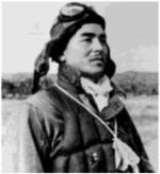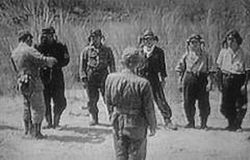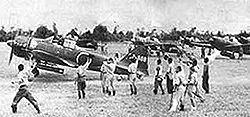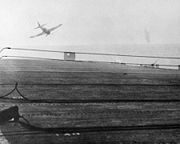
Hiroyoshi Nishizawa
Encyclopedia



Flying ace
A flying ace or fighter ace is a military aviator credited with shooting down several enemy aircraft during aerial combat. The actual number of aerial victories required to officially qualify as an "ace" has varied, but is usually considered to be five or more...
of the Imperial Japanese Navy Air Service
Imperial Japanese Navy Air Service
The Imperial Japanese Navy Air Service was the air arm of the Imperial Japanese Navy during World War II, the organization was responsible for the operation of naval aircraft and the conduct of aerial warfare in the Pacific War.It was controlled by the Navy Staff of the Imperial Japanese Navy and...
during World War II
World War II
World War II, or the Second World War , was a global conflict lasting from 1939 to 1945, involving most of the world's nations—including all of the great powers—eventually forming two opposing military alliances: the Allies and the Axis...
.
It is possible that Nishizawa was the most successful Japanese fighter ace of the war; he personally claimed to have had 87 aerial victories at the time of his death. Some uncertainty is due to the Japanese habit of recording victories for pilots' units, rather than the individual, after 1941, as well as the often wildly-exaggerated claims of aerial kills that were frequently accepted. Some sources credit Nishizawa with over 100 victories.
Early life
Hiroyoshi Nishizawa was born in a mountain village in the Nagano PrefectureNagano Prefecture
is a prefecture of Japan located in the Chūbu region of the island of Honshū. The capital is the city of Nagano.- History :Nagano was formerly known as the province of Shinano...
, the fifth son of Mikiji and Miyoshi Nishizawa. His father was the manager of a sake brewery.
Hiroyoshi graduated from higher elementary school and then began to work in a textile factory.
In June 1936, a poster caught his eye, an appeal for volunteers to join the Yokaren (flight reserve enlistee training program). Hiroyoshi applied and qualified as a student pilot in Class Otsu No. 7 of the Japanese Navy Air Force (JNAF). He completed his flight training course in March 1939, graduating 16th out of a class of 71.
Before the war, he served with the Oita, Omura and Sakura Kokutai
Kokutai
Kokutai is a politically loaded word in the Japanese language, translatable as "sovereign", "national identity; national essence; national character" or "national polity; body politic; national entity; basis for the Emperor's sovereignty; Japanese constitution". "Sovereign" is perhaps the most...
(air groups
Group (air force unit)
A group is a military aviation unit, a component of military organization and a military formation. Usage of the terms group and wing differ from one country to another, as well as different branches of a defence force, in some cases...
/wings
Wing (air force unit)
Wing is a term used by different military aviation forces for a unit of command. The terms wing, group or Staffel are used for different-sized units from one country or service to another....
).
In October 1941, he was transferred to the Chitose Kokutai, with the rank of petty officer 1st class.
New Guinea
After the outbreak of war with the AlliesPacific War
The Pacific War, also sometimes called the Asia-Pacific War refers broadly to the parts of World War II that took place in the Pacific Ocean, its islands, and in East Asia, then called the Far East...
, Nishizawa's squadron (chutai) from the Chitose Air Group, then flying the obsolete Mitsubishi A5M
Mitsubishi A5M
The Mitsubishi A5M, Japanese Navy designation was "Type 96 carrier-based fighter" was a Japanese carrier-based fighter aircraft. It was the world's first monoplane shipboard fighter and the direct ancestor of the famous Mitsubishi A6M 'Zero'...
, moved to Vunakanau
Vunakanau
Vunakanau Airfield was an aerodrome located near Vunakanau, East New Britain, Papua New Guinea. The airfield was constructed as a Royal Australian Air Force aerodrome and consisted of a unpaved single runway during World War II. The airfield was captured during the battle of Rabaul in 1942 by the...
airfield on the newly taken island of New Britain
New Britain
New Britain, or Niu Briten, is the largest island in the Bismarck Archipelago of Papua New Guinea. It is separated from the island of New Guinea by the Dampier and Vitiaz Straits and from New Ireland by St. George's Channel...
. The squadron received its first Mitsubishi Zeros (A6M2, Model 21) the same week.
On 3 February, Nishizawa, still flying an obsolete A5M, claimed his first aerial kill of the war, a PBY Catalina
PBY Catalina
The Consolidated PBY Catalina was an American flying boat of the 1930s and 1940s produced by Consolidated Aircraft. It was one of the most widely used multi-role aircraft of World War II. PBYs served with every branch of the United States Armed Forces and in the air forces and navies of many other...
; historians have confirmed, however, that the plane was only damaged and managed to return to base. On 10 February, Nishizawa's squadron was transferred to the newly formed 4th Air Group. As new Zeros became available, Nishizawa was assigned an A6M2 bearing the tail code F-108.
On 1 April, Nishizawa's squadron was transferred to Lae
Lae
Lae, the capital of Morobe Province, is the second-largest city in Papua New Guinea. It is located at the start of the Highlands Highway which is the main land transport corridor from the Highlands region to the coast...
, New Guinea
New Guinea
New Guinea is the world's second largest island, after Greenland, covering a land area of 786,000 km2. Located in the southwest Pacific Ocean, it lies geographically to the east of the Malay Archipelago, with which it is sometimes included as part of a greater Indo-Australian Archipelago...
and assigned to the Tainan Air Group
Tainan Air Group
was a fighter aircraft and airbase garrison unit of the Imperial Japanese Navy during the Pacific campaign of World War II. The flying portion of the unit was heavily involved in many of the major campaigns and battles of the first year of the war...
. There he flew with aces Saburō Sakai
Saburo Sakai
Sub-Lieutenant was a Japanese naval aviator and flying ace of the Imperial Japanese Navy during World War II. Sakai was the Imperial Navy's fourth-ranking ace and Japan's second leading fighter pilot to survive the war ....
and Toshio Ōta in a chutai (squadron) led by Junichi Sasai
Junichi Sasai
Lieutenant Commander was a Japanese naval aviator and fighter ace of the Imperial Japanese Navy during World War II. Lieutenant Sasai was killed leading his fighter squadron during an attack of Henderson Field during the Battle of Guadalcanal....
. Sakai described his friend Nishizawa as about 5-foot-8, 140 lb (63.5 kg) in weight, pale and gaunt, suffering constantly from malaria and tropical skin diseases. Accomplished at judo, his squadron mates, who nicknamed him the "Devil," considered him a reserved, taciturn loner. Of his performance in the air, Sakai, himself one of Japan's leading aerial aces, wrote, "Never have I seen a man with a fighter plane do what Nishizawa would do with his Zero. His aerobatics were all at once breathtaking, brilliant, totally unpredictable, impossible, and heart-stirring to witness."
They often clashed with United States Army Air Forces
United States Army Air Forces
The United States Army Air Forces was the military aviation arm of the United States of America during and immediately after World War II, and the direct predecessor of the United States Air Force....
and Royal Australian Air Force
Royal Australian Air Force
The Royal Australian Air Force is the air force branch of the Australian Defence Force. The RAAF was formed in March 1921. It continues the traditions of the Australian Flying Corps , which was formed on 22 October 1912. The RAAF has taken part in many of the 20th century's major conflicts...
fighters operating from Port Moresby
Port Moresby
Port Moresby , or Pot Mosbi in Tok Pisin, is the capital and largest city of Papua New Guinea . It is located on the shores of the Gulf of Papua, on the southeastern coast of the island of New Guinea, which made it a prime objective for conquest by the Imperial Japanese forces during 1942–43...
. Nishizawa's first confirmable solo kill, of a USAAF P-39 Airacobra, was on 11 April. He claimed six more kills in a 72-hour period from 1–3 May, making him a confirmed fighter ace. Nishizawa was a member of the famed "Cleanup Trio" with Saburō Sakai
Saburo Sakai
Sub-Lieutenant was a Japanese naval aviator and flying ace of the Imperial Japanese Navy during World War II. Sakai was the Imperial Navy's fourth-ranking ace and Japan's second leading fighter pilot to survive the war ....
and Toshio Ōta.
In the night of 16 May, Nishizawa, Sakai and Ōta were listening at the lounge room to a broadcast of an Australian radio program, when Nishizawa recognized the eerie Danse Macabre
Danse Macabre (Saint-Saëns)
Danse macabre, Op. 40, is a tone poem for orchestra, written in 1874 by French composer Camille Saint-Saëns. It started out in 1872 as an art song for voice and piano with a French text by the poet Henri Cazalis, which is based in an old French superstition...
of the French composer, pianist and organist Camille Saint-Saëns
Camille Saint-Saëns
Charles-Camille Saint-Saëns was a French Late-Romantic composer, organist, conductor, and pianist. He is known especially for The Carnival of the Animals, Danse macabre, Samson and Delilah, Piano Concerto No. 2, Cello Concerto No. 1, Havanaise, Introduction and Rondo Capriccioso, and his Symphony...
. Nishizawa, thinking about this mysterious skeleton dance, now suddenly had a crazy idea: "you know the mission tomorrow at Port Moresby? Why don't we perform a little show, a dance of death of our own? We do a few demonstration loops right over the enemy airfield, this should drive them crazy on the ground."
On May 17, Lieutenant Commander
Lieutenant Commander
Lieutenant Commander is a commissioned officer rank in many navies. The rank is superior to a lieutenant and subordinate to a commander...
Tadashi "Shosa" Nakajima led the Tainan Ku on a mission to Port Moresby, with Sakai and Nishizawa as his wingmen. As the Japanese formation re-formed for the return flight, Sakai signaled Nakajima, that he was going after an enemy aircraft and peeled off. Minutes later, Sakai was over Port Moresby again, to keep his rendezvous with Nishizawa and Ōta. The trio now performed aerobatics, three tight loops in close formation. After that, a jubilant Nishizawa indicated that he wanted to repeat the performance. Diving to 6000 ft (1,828.8 m), the three Zeros did three more loops, still without any AA fire from the ground. They headed then back to Lae, arriving 20 minutes after, the rest of the kokutai.
At about 21:00, Lieutenant Junichi Sasai
Junichi Sasai
Lieutenant Commander was a Japanese naval aviator and fighter ace of the Imperial Japanese Navy during World War II. Lieutenant Sasai was killed leading his fighter squadron during an attack of Henderson Field during the Battle of Guadalcanal....
wanted them in his office, immediately. When they arrived, Sasai held up a letter. "Do you know where I got this thing?" he shouted. "No? I'll tell you, you fools; it was dropped on this base a few minutes ago, by an enemy intruder!" The letter, written in English, said:
To the Lae Commander: "We were much impressed with those three pilots who visited us today, and we all liked the loops they flew over our field. It was quite an exhibition. We would appreciate it if the same pilots returned here once again, each wearing a green muffler around his neck. We're sorry we could not give them better attention on their last trip, but we will see to it that the next time they will receive an all-out welcome from us."
Nishizawa, Sakai and Ōta stood at stiff attention and tried to suppress laughing out loud, while Lieutenant Sasai dressed them down over their "idiotic behavior" and prohibited them from staging any more aerobatic shows over enemy airfields. The Tainan Kokutai's three leading aces secretly agreed, that the aerial choreography had been worth it.

Guadalcanal
In early August 1942, the air group moved to RabaulRabaul
Rabaul is a township in East New Britain province, Papua New Guinea. The town was the provincial capital and most important settlement in the province until it was destroyed in 1994 by falling ash of a volcanic eruption. During the eruption, ash was sent thousands of metres into the air and the...
, immediately operating against the US forces on Guadalcanal
Guadalcanal
Guadalcanal is a tropical island in the South-Western Pacific. The largest island in the Solomons, it was discovered by the Spanish expedition of Alvaro de Mendaña in 1568...
. In the first clash on 7 August, Nishizawa claimed six F4F Wildcat
F4F Wildcat
The Grumman F4F Wildcat was an American carrier-based fighter aircraft that began service with both the United States Navy and the British Royal Navy in 1940...
s (historians have confirmed two kills).
On 8 August 1942, Saburō Sakai
Saburo Sakai
Sub-Lieutenant was a Japanese naval aviator and flying ace of the Imperial Japanese Navy during World War II. Sakai was the Imperial Navy's fourth-ranking ace and Japan's second leading fighter pilot to survive the war ....
, Nishizawa's closest friend, was severely injured in combat with U.S. Navy SBD Dauntless dive bombers. Nishizawa noticed that Sakai was missing and went into a mad rage, he searched the area, both for signs of Sakai and for Americans to fight, presumably even if he had to ram them. Eventually, he cooled off and returned to Lakunai. Later, to everyone's amazement, the seriously wounded Sakai arrived. Struck across his head by a bullet, covered with blood and blind in one eye, he returned to base with his damaged Zero, after a four-hour, 47-minute flight over 560 nmi (1,037.1 km; 644.4 mi). Nishizawa, Lieutenant Sasai and Toshio Ōta transported the obstinate but unconscious Sakai to the hospital. In frustrated concern Nishizawa physically removed the waiting driver and personally drove Sakai, as quickly but as gently as possible, to the surgeon. Saburō Sakai was evacuated to Japan on 12 August.
The extended conflict over Guadalcanal was costly for Nishizawa's air group (renamed as the 251st in November) as American aircraft and tactics improved: Sasai (with 27 victories) was shot down and killed by Captain Marion E. Carl
Marion E. Carl
Major General Marion Eugene Carl, USMC, was a World War II fighter ace, record setting test pilot, and a notable naval aviator. He was the first Marine Corps ace in World War II.-Early years:...
on August 26, and Ōta (34 kills) was killed on October 21.
Return to Japan
In mid-November, the 21st was recalled to Toyohashi air base in Japan to replace its losses, with the ten surviving pilots all being made instructors, including Nishizawa. Nishizawa is believed to have had around forty full or partial aerial victories by this time (some sources claim 54).Nishizawa, while staying in Japan, visited Saburō Sakai
Saburo Sakai
Sub-Lieutenant was a Japanese naval aviator and flying ace of the Imperial Japanese Navy during World War II. Sakai was the Imperial Navy's fourth-ranking ace and Japan's second leading fighter pilot to survive the war ....
, who was still recuperating in the Yokosuka hospital. Nishizawa complained to Sakai of his new duty as an instructor: "Saburō, can you picture me running around in a rickety old biplane, teaching some fool youngster how to bank and turn, and how to keep his pants dry?" Nishizawa also ascribed the loss of most of their comrade pilots to the ever increasing material advantage of the allied forces, the improved U.S. aircraft and tactics. "It's not as you remember, Saburō," he said. "There was nothing I could do. There were just too many enemy planes, just too many." Even so, Nishizawa could not wait to return to combat. "I want a fighter under my hands again," he said. "I simply have to get back into action. Staying home in Japan is killing me."
Nishizawa publicly chafed at the months of inaction in Japan. He and the 251st returned to Rabaul in May 1943. In June 1943, Nishizawa's achievements were honored by a gift from the commander of the 11th Air Fleet, Vice Admiral Jin'ichi Kusaka. Nishizawa received a military sword
Katana
A Japanese sword, or , is one of the traditional bladed weapons of Japan. There are several types of Japanese swords, according to size, field of application and method of manufacture.-Description:...
inscribed Buko Batsugun ("For Conspicuous Military Valor"). He was then transferred to the 253rd Air Group on New Britain in September. In November, he was promoted to warrant officer and re-assigned to training duties in Japan with the Oita Air Group.
In February 1944, he joined the 203rd Air Group operating from the Kurile Islands, away from heavy action.
Philippines campaign
In October, however, the 203rd was transferred to LuzonLuzon
Luzon is the largest island in the Philippines. It is located in the northernmost region of the archipelago, and is also the name for one of the three primary island groups in the country centered on the Island of Luzon...
. Nishizawa and four others were detached to a smaller airfield on Cebu.
On 25 October, he led the fighter escort consisting of four A6M5s, flown by Nishizawa, Misao Sugawa, Shingo Honda and Ryoji Baba for the first major kamikaze
Kamikaze
The were suicide attacks by military aviators from the Empire of Japan against Allied naval vessels in the closing stages of the Pacific campaign of World War II, designed to destroy as many warships as possible....
attack of the war. Target for this attack was V. Adm. Clifton Sprague
Clifton Sprague
Vice Admiral Clifton Albert Frederick Sprague was a World War II-era officer in the United States Navy.-Biography:...
's "Taffy 3" task force, defending the landings in the Battle of Leyte Gulf
Battle of Leyte Gulf
The Battle of Leyte Gulf, also called the "Battles for Leyte Gulf", and formerly known as the "Second Battle of the Philippine Sea", is generally considered to be the largest naval battle of World War II and, by some criteria, possibly the largest naval battle in history.It was fought in waters...
.



Yukio Seki
was a Japanese naval aviator of the Imperial Japanese Navy during World War II. As a kamikaze pilot Lieutenant Seki led one of the three fighter groups of the second official kamikaze attack in World War II . Seki's final action took place on October 25, 1944, during the Battle of Leyte Gulf...
, piloted five bomb-armed A6M2 Model 21 Zeros, each carrying a 250 kg (551.2 lb) bomb. They crash-dived their planes deliberately into U.S. warships in the first official kamikaze attack of the Tokkōtai suicide squadron "Shikishima". They were the first kamikazes to sink an enemy ship. The attack was very successful, as four of the five kamikazes struck their targets, and inflicted heavy damage. An A6M2 likely flown by Lt. Yukio Seki crashed onto the flight deck of the escort carrier at 10:53. The Zero's 250 kg (551.2 lb) bomb exploded on the portside hangar deck, resulting in a fire and secondary explosions which soon detonated torpedoes and the bomb magazine of St. Lo. The escort carrier sank half an hour later, 126 men were lost in action. Lieutenant Yukio Seki
Yukio Seki
was a Japanese naval aviator of the Imperial Japanese Navy during World War II. As a kamikaze pilot Lieutenant Seki led one of the three fighter groups of the second official kamikaze attack in World War II . Seki's final action took place on October 25, 1944, during the Battle of Leyte Gulf...
is recorded as saying before the mission: "Japan's future is bleak if it is forced to kill one of its best pilots. I am not going on this mission for the Emperor or for the Empire... I am going because I was ordered to!"
While flying fighter escort to this mission, Nishizawa records his 86th and 87th victories (both F6F Hellcat
F6F Hellcat
The Grumman F6F Hellcat was a carrier-based fighter aircraft developed to replace the earlier F4F Wildcat in United States Navy service. Although the F6F resembled the Wildcat, it was a completely new design powered by a 2,000 hp Pratt & Whitney R-2800. Some tagged it as the "Wildcat's big...
s), the final aerial victories of his career.
Nishizawa had a premonition during the flight, he saw in a vision
Vision (religion)
In spirituality, a vision is something seen in a dream, trance, or ecstasy, especially a supernatural appearance that conveys a revelation.Visions generally have more clarity than dreams, but traditionally fewer psychological connotations...
his own death. Nishizawa reported the sortie's success to Commander Nakajima after returning to base. He then volunteered to take part in the next day's Tokkōtai kamikaze mission. Of course, he was refused, a pilot of such brilliance was of more value to his country behind the controls of a fighter plane than diving into a carrier.
Instead, Nishizawa's A6M5 Zero was armed with a 250 kg (551.2 lb) bomb and flown by Naval Air Pilot 1st Class Tomisaku Katsumata. A less experienced pilot, he nevertheless dove into the escort carrier off Surigao. Katsumata crashed on Suwanees flight deck and careened into a torpedo bomber which had just been recovered. The two planes erupted upon contact as did nine other planes on her flight deck. Although the ship was not sunk, she burned for several hours, and 85 of her crewmen were killed, 58 were missing and 102 wounded.
Death
The following day, his own Zero having been destroyed, Nishizawa and other pilots of the 201st Kokutai boarded a Nakajima Ki-49Nakajima Ki-49
|-See also:-References:NotesBibliography* Bueschel, Richard M. Nakajima Ki-49 Donryu in Japanese Army Air Force Service. Atglen, PA: Schiffer Publishing Ltd., 2004. ISBN 0-76430-344-9....
Donryu ("Helen") transport plane and left Mabalacat on Cebu in the morning, to ferry replacement Zeros from Clark Field on Luzon
Luzon
Luzon is the largest island in the Philippines. It is located in the northernmost region of the archipelago, and is also the name for one of the three primary island groups in the country centered on the Island of Luzon...
.
Over Calapan on Mindoro Island, the Ki-49 transport was attacked by two F6F Hellcats of VF-14 squadron from the fleet carrier and was shot down in flames. Nishizawa died as a helpless passenger, probably the victim of Lt. j.g. Harold P. Newell, who was credited with a "Helen" northeast of Mindoro that morning.
Warrant Officer Hiroyoshi Nishizawa, Japan’s leading ace, had been killed at the age of 24.
Upon learning of Nishizawa's death, the commander of the Combined Fleet, Admiral Soemu Toyoda, honored Nishizawa with a mention in an all-units bulletin and posthumously promoted him to the rank of lieutenant junior-grade
Naval ranks of the Japanese Empire during World War II
The following graphs present the rank insignia of the Japanese navy during World War II. These designs had been used from 1931-1945, but were discontinued after World War II, when the Imperial Japanese Navy had been dissolved....
. Nishizawa was also given the posthumous name Bukai-in Kohan Giko Kyoshi, a Zen Buddhist phrase that translates: "In the ocean of the military, reflective of all distinguished pilots, an honored Buddhist person." Because of the confusion towards the end of the Pacific war, the bulletin's publication was delayed and funeral services were not held until December 2, 1947.

